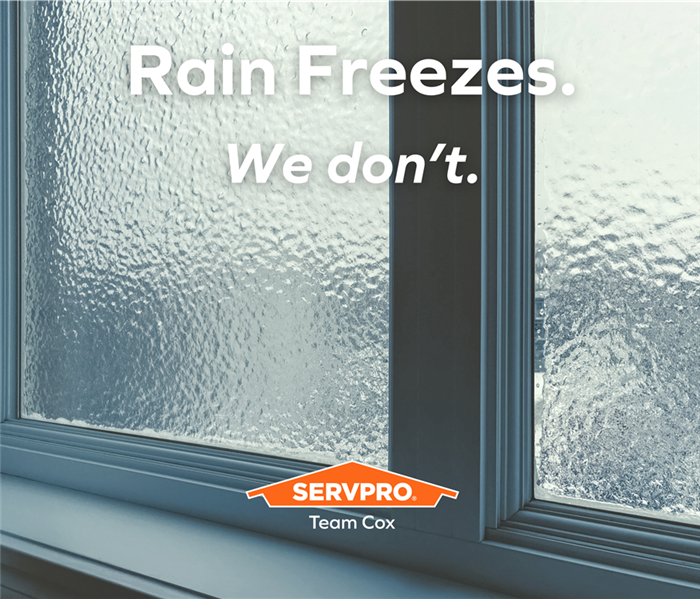Protecting Your Home from the Dangers of Freezing Rain: Insights from SERVPRO Team Cox
2/20/2025 (Permalink)
Winter weather can bring a host of challenges for homeowners, but one of the most dangerous and underestimated threats is freezing rain. Unlike snow, which can be shoveled away, freezing rain coats everything in a layer of ice that can lead to serious damage. At SERVPRO®, we’ve witnessed firsthand the havoc freezing rain can wreak on homes, from structural damage to burst pipes and water intrusion. This blog will explore the hidden dangers of freezing rain, how it can impact your home, and what you can do to safeguard your property.
Understanding Freezing Rain
Freezing rain occurs when rain falls through a layer of cold air close to the ground, causing it to freeze upon contact with surfaces. This creates a thin, yet heavy layer of ice that can cling to roofs, trees, power lines, and driveways. Unlike sleet or snow, freezing rain doesn’t accumulate as ice pellets; instead, it forms a smooth, solid layer of ice that can be difficult to remove and incredibly damaging.
How Freezing Rain Puts Your Home at Risk
- Roof Stress and Potential Collapse
A seemingly small layer of ice can add significant weight to your roof, potentially straining its structural integrity. Older homes or those with flat roofs are particularly vulnerable. As ice accumulates, the added pressure can lead to cracks, sagging, and even roof collapse, causing extensive interior damage.
- Ice Dams and Water Infiltration
Ice dams form when ice builds up at the edges of your roof, preventing melting snow and rain from draining properly. As water pools behind the dam, it can seep beneath shingles and leak into your home, damaging ceilings, walls, insulation, and electrical systems. This moisture can also create the perfect environment for mold growth, which poses health risks and can be costly to remediate.
- Burst Pipes and Water Damage
When freezing rain is accompanied by low temperatures, your home’s plumbing system is at risk of freezing. Pipes located in unheated areas like basements, attics, and exterior walls are particularly vulnerable. When water inside a pipe freezes, it expands, increasing pressure until the pipe bursts. Even a small crack can release gallons of water, leading to flooding, damaged belongings, and structural issues.
- Power Outages and Fire Hazards
The weight of ice on power lines and tree branches can cause them to break, leading to widespread power outages. Without power, your heating system may fail, increasing the risk of frozen pipes and other cold-weather damage. Additionally, using alternative heat sources like space heaters, fireplaces, or generators can pose fire hazards if not used correctly.
Repeated freezing and thawing cycles can weaken your home’s foundation and exterior walls. As ice forms in cracks and crevices, it expands, causing the gaps to widen. Over time, this process can lead to structural instability, compromised insulation, and costly repairs.
Proactive Steps to Safeguard Your Home
While freezing rain is unpredictable, there are proactive measures you can take to minimize the risk of damage:
- Inspect and Maintain Your Roof: Schedule regular roof inspections to identify and repair any signs of wear or damage. Ensure your gutters and downspouts are clear of debris to allow proper drainage.
- Seal Cracks and Gaps: Seal any cracks or gaps in your home’s exterior to prevent cold air from reaching your pipes. Insulate pipes in unheated areas and consider using heat tape for added protection.
- Trim Tree Branches: Trim branches that overhang your home or power lines to reduce the risk of ice-related damage.
- Install a Backup Generator: A backup generator can keep your heating system running during power outages, helping to prevent frozen pipes and other cold-weather issues.
- Use a Roof Rake: If ice dams form, use a roof rake to remove snow and ice from the edges of your roof. Avoid using sharp tools that could damage shingles.
- Maintain Proper Insulation: Ensure your attic is properly insulated to prevent heat loss and minimize the risk of ice dams forming.
What to Do If Your Home Sustains Damage
Despite taking preventative measures, freezing rain can still cause unexpected damage. If your home is affected, it’s essential to act quickly to minimize the impact. Here’s what you should do:
- Prioritize Safety: If there’s significant structural damage or a risk of collapse, evacuate your home and contact emergency services. Avoid standing water if electrical outlets or appliances are submerged.
- Shut Off Utilities: Turn off the main water supply to prevent further flooding if a pipe has burst. If you suspect electrical damage, shut off power at the circuit breaker.
- Document the Damage: Take photos and videos of the damage, both inside and outside your home, for insurance purposes.
- Contact Your Insurance Company: Notify your insurance company as soon as possible to start the claims process. Provide them with the documentation you’ve gathered.
- Call SERVPRO Team Cox: Our experienced team is available 24/7 to respond to water and storm damage emergencies. We’ll assess the damage, extract water, and begin the drying and restoration process to return your home to its pre-damage condition.
Why SERVPRO Team Cox Is the Right Choice
At SERVPRO Team Cox, we understand the stress and disruption that storm damage can cause. Our team of certified professionals is equipped with advanced tools and techniques to handle water extraction, structural drying, mold remediation, and reconstruction. We pride ourselves on our fast response times, exceptional customer service, and commitment to restoring your home quickly and efficiently.
We know that every minute counts when it comes to storm damage. That’s why we’re available 24/7 to respond to emergencies and begin the restoration process immediately. Our goal is to minimize the disruption to your life and help you get back to normal as quickly as possible. Call us at 704-393-7890.

 24/7 Emergency Service
24/7 Emergency Service
